Phylum Chordata | Class Reptilia Rank Species | |
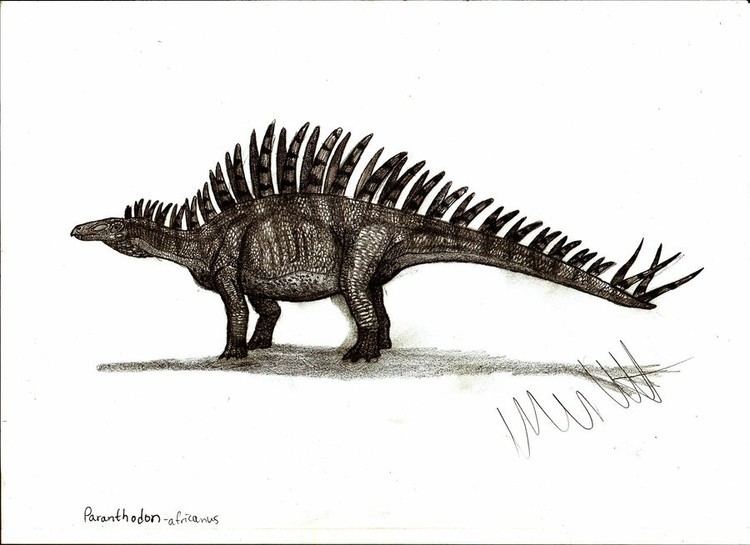 | ||
Genus †ParanthodonNopcsa, 1929 Similar Chialingosaurus, Regnosaurus, Craterosaurus, Jiangjunosaurus, Monkonosaurus | ||
Paranthodon abcsaurio
Paranthodon (pə-RAN-thə-don) is a genus of extinct stegosaurian dinosaur that lived in South Africa during the Early Cretaceous, between 145.5 and 136.4 million years ago. Discovered in 1845, it was one of the first stegosaurians found. Its only remains, a partial skull and isolated teeth, were found in the Kirkwood Formation. British paleontologist Richard Owen initially identified the fragments as those of the pareiasaur Anthodon. After remaining untouched for years in the British Museum of Natural History, the partial skull was identified by South African paleontologist Robert Broom as belonging to a different genus; he named the specimen Palaeoscincus africanus. Several years later, Hungarian paleontologist Franz Nopcsa, unaware of Broom's new name, similarly concluded that it represented a new taxon, and named it Paranthodon owenii. Since Nopcsa's species name was assigned after Broom's, and Broom did not assign a new genus, both names are now synonyms of the current binomial, Paranthodon africanus. The genus name combines the Ancient Greek para (near) with the genus name Anthodon, to represent the initial referral of the remains.
Contents
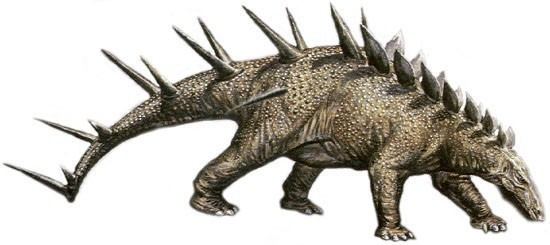
In identifying the remains as those of Palaeoscincus, Broom initially classified Paranthodon as an ankylosaurian, a statement backed by the research of Coombs in the 1970s. However, in 1929, Nopcsa identified the taxon as a stegosaurid, with which most modern studies agree. In 1981, the genus was reviewed with modern taxonomy, and found to be a valid genus of stegosaurid. However, a more recent 2008 review of Stegosauria could only identify one distinguishing feature, and while that study still referred it to Stegosauridae based on similarity, no diagnostic features of the family could be identified in Paranthodon.
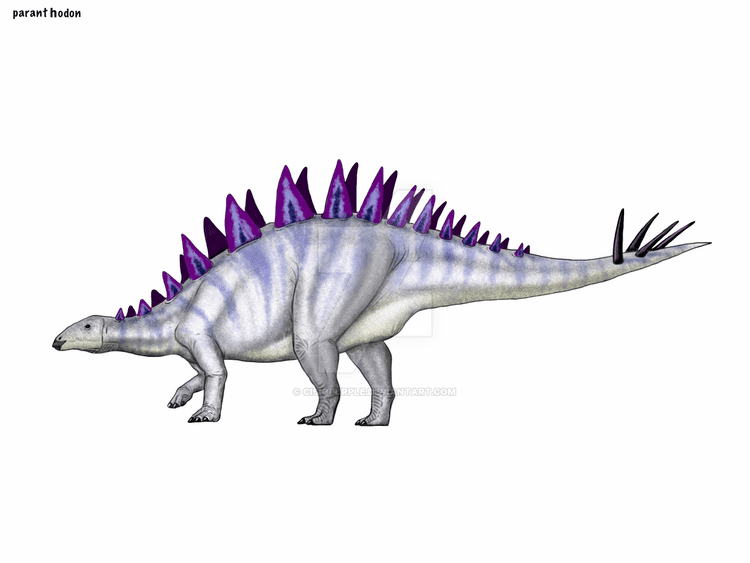
Description
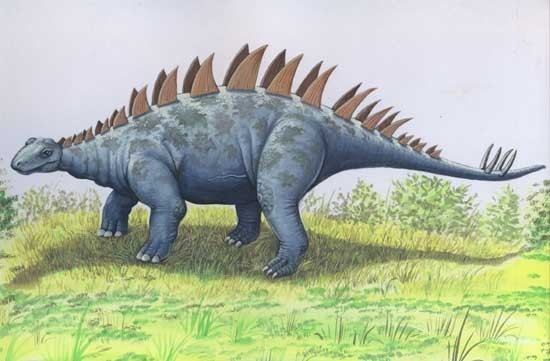
Paranthodon was a small relative of larger stegosaurids such as Stegosaurus. Thomas R. Holtz Jr. estimated that the animal was 5.0 m (16.4 ft) long and weighed between 454 and 907 kg (1,001 and 2,000 lb). The snout is elongated, though not extremely so, and convex on top. The back of the premaxilla is long and broad, and the external nares are large. The teeth have a prominent primary ridge. The fossilized nasal and maxillary bones are relatively complete, and an incomplete premaxilla is also preserved. The partial snout resembles Stegosaurus in its large posterior premaxillary process and the extension of the palate. However, Stegosaurus is the only stegosaurid known from adequate cranial material to compare with Paranthodon, and even though their resemblance is great, tooth morphology is very distinguishing among the stegosaurians. For example, cranial material is only known from Stegosaurus, Paranthodon, Kentrosaurus, and Tuojiangosaurus, and the tooth morphology differs in all of them.
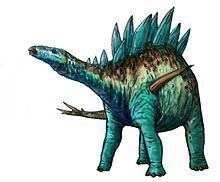
The maxilla of Paranthodon preserves the tooth row, and shows that there is little to no overhang. This differs from ankylosaurians, where there is a large amount of overhang of the maxilla. The teeth also have a middle ridge, with five fewer prominent ridges on either side. This is similar to the size ridges seen on Kentrosaurus. Like all stegosaurians, the denticles on the teeth are rounded at the tips, in contrast to ankylosaurians. Also, like Huayangosaurus, but unlike Kentrosaurus and Stegosaurus, Paranthodon possesses a prominent buccal margination (a ridge beside the tooth row). Paranthodon teeth preserve wear, but wear is absent on most teeth, similar to Huayangosaurus, meaning it is likely that Paranthodon lacked occlusion between teeth. Paranthodon is distinguished from other stegosaurs by a long, wide, posterior process of the premaxilla, teeth in the maxilla with a very large cingulum, and large ridges on the tooth crowns. Not all of these features were considered valid in a 2008 review of Stegosauria, with the only autapomorphy found being the possession of a partial second bony palate on the maxilla.
Discovery and naming
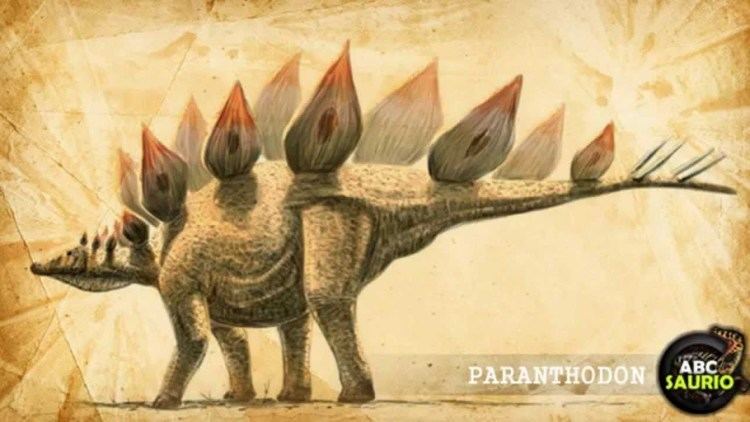
In 1845, amateur geologists William Guybon Atherstone and Andrew Geddes Bain discovered several fossils near Dassieklip, Cape Province, in the Bushmans River Valley. This was the first dinosaur find in all of the Southern Hemisphere and Africa. In 1849 and 1853, Bain sent some of the fossils to Richard Owen for identification. Among them was an upper jaw Bain referred to as the "Cape Iguanodon", so the site was named "Iguanodonhoek". Atherstone published a short paper about the discovery in 1857, but lamented in 1871 that it had thus far received no attention in London. Only in 1876 were a series of specimens from the collection named by Owen as Anthodon serrarius, basing the generic name on the resemblance of the teeth to a flower. The partial holotype skull BMNH 47337, the left jaw BMNH 47338, the matrix BMNH 47338 including bone fragments and impressions of the anterior skull, and the vertebrae BMNH 47337a were all assigned to Anthodon. In 1882, Othniel Charles Marsh assigned Anthodon to Stegosauridae based on BMNH 47338, and in 1890, Richard Lydekker found that although Anthodon was a pareiasaur, its teeth were similar to those of the Stegosauridae.
In 1909, Robert Broom visited the collection of the British Museum of Natural History. He concluded that Owen had mixed the partial distorted skull, teeth, and a mandible of a pareiasaur and a partial upper jaw of a dinosaur, BMNH 47338, which were actually from two different species. Broom kept the name Anthodon for the pareiasaur, but identified the other fossil as a member of the genus Palaeoscincus, naming the new species Paleoscincus africanus in 1912. He found that the anatomy of the teeth were quite different, even though they resembled each other, as well as those of Stegosaurus. In 1929, Franz Nopcsa, unaware of Broom's previous publication, provided a new name for Broom's P. africanus, as D.M.S. Watson believed that the jaw should be differentiated from Anthodon. Nopcsa named the species Paranthodon Owenii, with the generic name derived from the Latin para, meaning "similar", "near", or "beside", and Anthodon, and specific name honoring Owen. Due to present conventions, the specific name was later emended to owenii. Both names were brought into the current nomenclature by Walter P. Coombs in his 1971 dissertation as the new combination Paranthodon africanus, as the name Paranthodon was the first new generic name for the fossils and africanus was the first new specific name. This makes Paranthodon africanus the proper name for the taxon previously known as Palaeoscincus africanus and Paranthodon owenii.
The holotype of Paranthodon, BMNH 47338, was found in a layer of the Kirkwood Formation that has been dated between the Berriasian and early Valanginian ages. It consists of the back of the snout, containing the maxilla with teeth, the posterior caudodorsal ramus of the premaxilla, part of the nasals, and some isolated teeth probably from the lower jaw. One additional specimen can be assigned to it based on the dentition, BMNH 47992, including only isolated teeth sharing the same morphology as those from the holotype. However, the teeth do not bear any autapomorphies of Paranthodon, and were referred to an indeterminate stegosaurid in 2008.
Classification
Currently, Paranthodon is classified as a stegosaur related to Stegosaurus, Tuojiangosaurus, and Loricatosaurus. Initially, when Broom assigned the name Palaeoscincus africanus to the Paranthodon fossils, he classified them as an ankylosaurian. This classification was later changed by Nopcsa, who found that Paranthodon best resembled a stegosaurid (before the group was truly defined). Coombs (1978) did not follow Nopcsa's classification, keeping Paranthodon as an ankylosaurian, like Broom, although he only classified it as Ankylosauria incertae sedis. A subsequent review by Galton and Coombs in 1981 instead confirmed Nopcsa's interpretation, redescribing Paranthodon as a stegosaurid from the Late Cretaceous. Multiple phylogenetic analyses have placed Paranthodon in Stegosauria, and often in Stegosauridae. A 2010 analysis including nearly all species of stegosaurians found that Paranthodon was outside Stegosauridae, and in a polytomy with Tuojiangosaurus, Huayangosaurus, Chungkingosaurus, Jiangjunosaurus, and Gigantspinosaurus. However, when the latter two genera were removed, Paranthodon grouped with Tuojiangosaurus just outside Stegosauridae, and Huayangosaurus grouped with Chungkingosaurus in Huayangosauridae. Below is the analysis with all included genera.
Other analyses have found Paranthodon closely related to Tuojiangosaurus, Loricatosaurus, and Kentrosaurus within Stegosaurinae. Even though phylogenetic analyses recognize Paranthodon as a stegosaurid, the type material actually bears no synapomorphies of Stegosauria. However, the material is likely of stegosaurian nature, and phylogenies by many authors have found it to be within the group.
Paleoecology
The Kirkwood Formation is in South Africa, and many fossils of different species and genera have been discovered in it, with Paranthodon being the first uncovered. The formation is of a Late Jurassic to Early Cretaceous age, with the oldest deposits from the Tithonian, about 145.5 million years ago, and the youngest rocks being from the Valanginian, about 136.4 million years ago. A large variety of different animal groups have been found in the formation, including dinosaurs, at least two different sphenodontian lizards, multiple teleost fishes, a few crocodylians, some frog specimens, and also turtles. However, a large amount of the material of the Kirkwood formation only includes isolated teeth or partial and fragmentary pieces of bone. Dinosaurs of the formation include a basal tetanuran, the primitive ornithomimosaurian Nqwebasaurus, the possible brachiosaurid Algoasaurus, a potential titanosaurian, many ornithischians, Paranthodon, a genus of iguanodontian, and a "hypsilophodontid" (the family Hypsilophodontidae is no longer considered to be a natural grouping).
